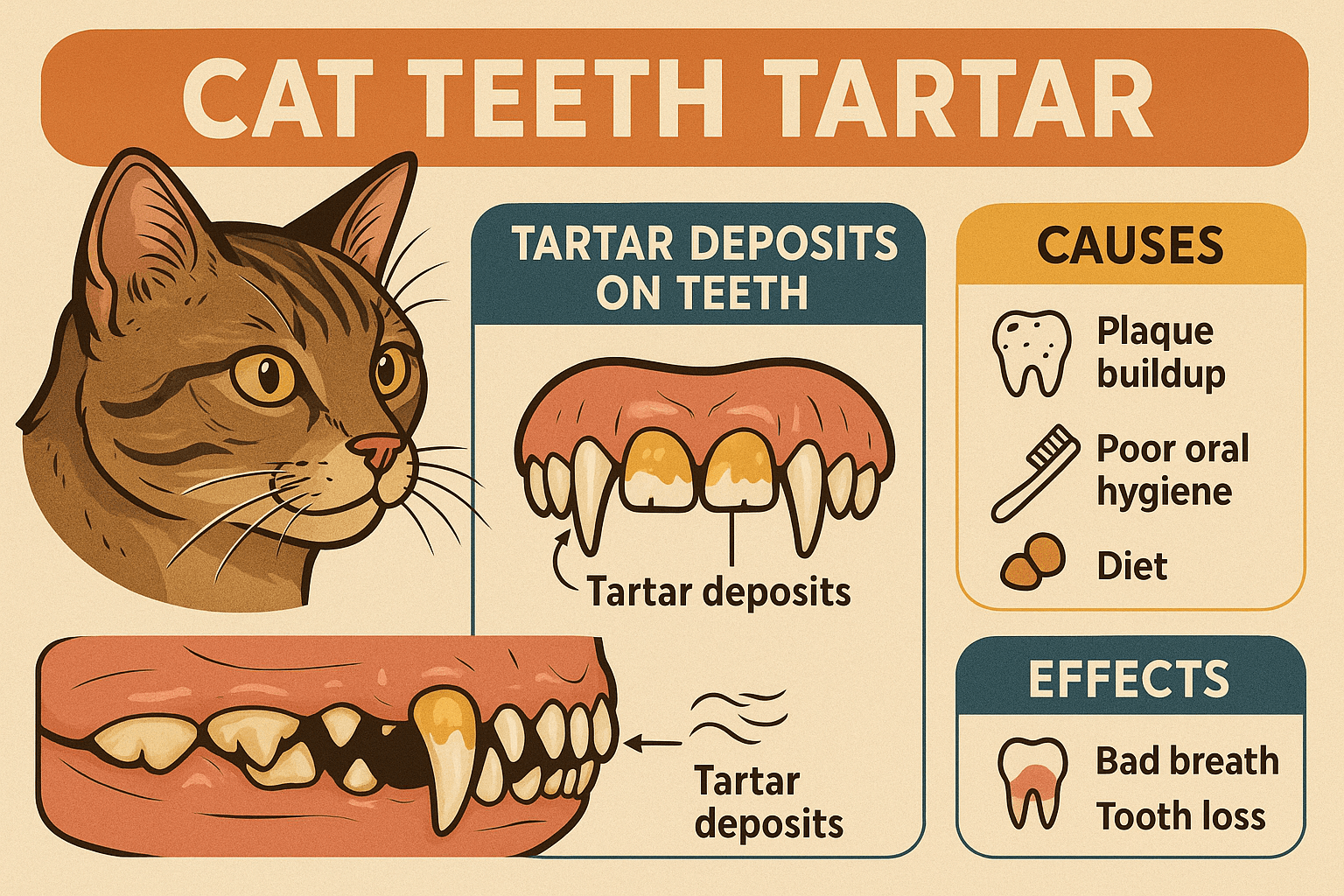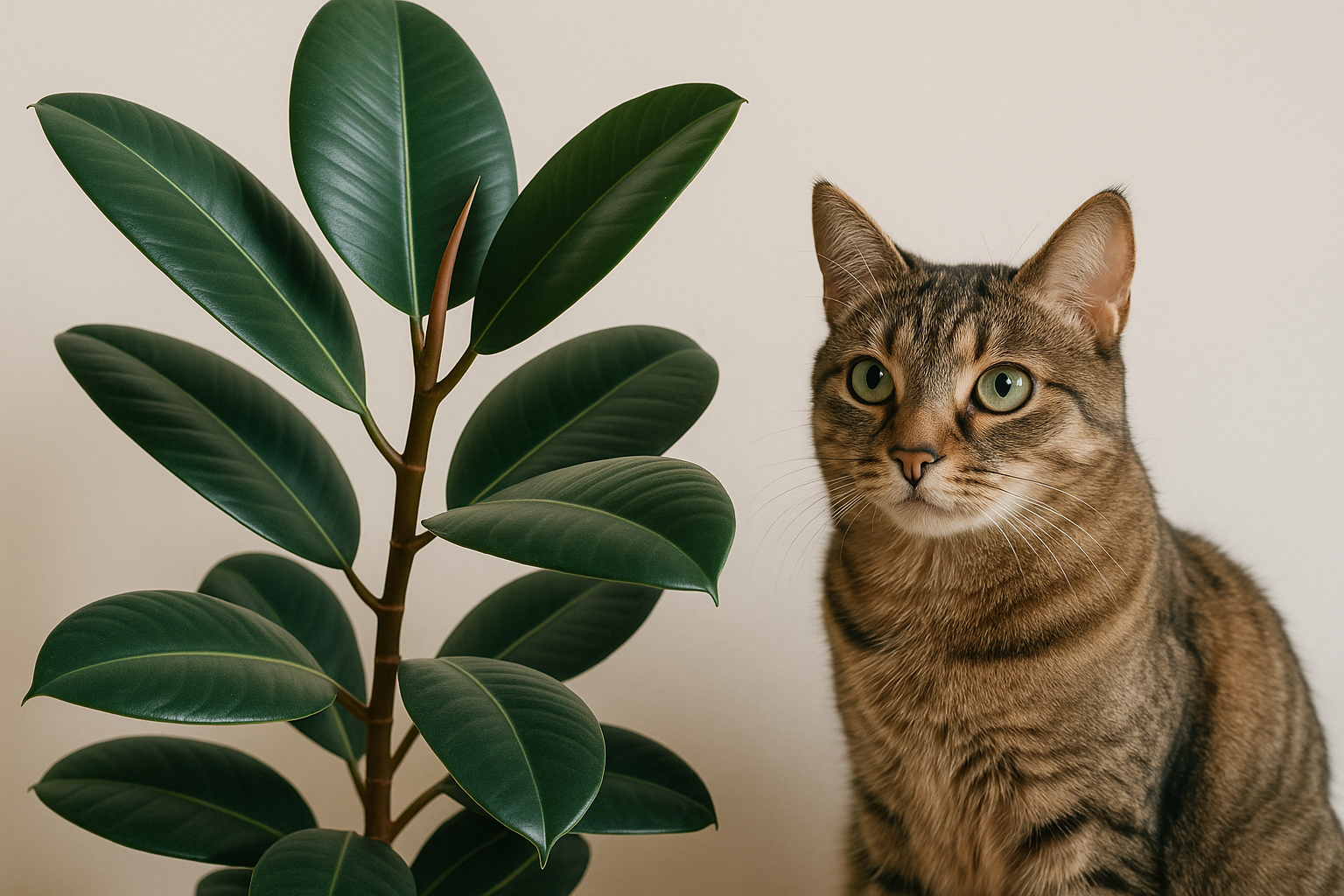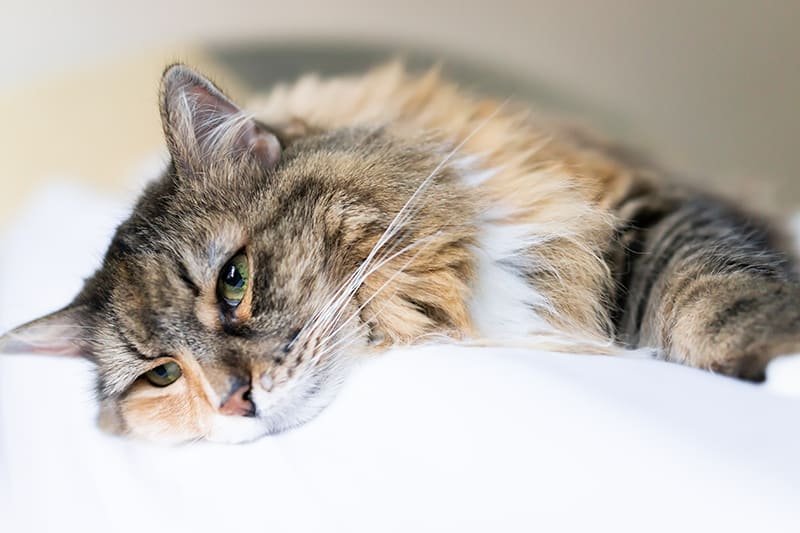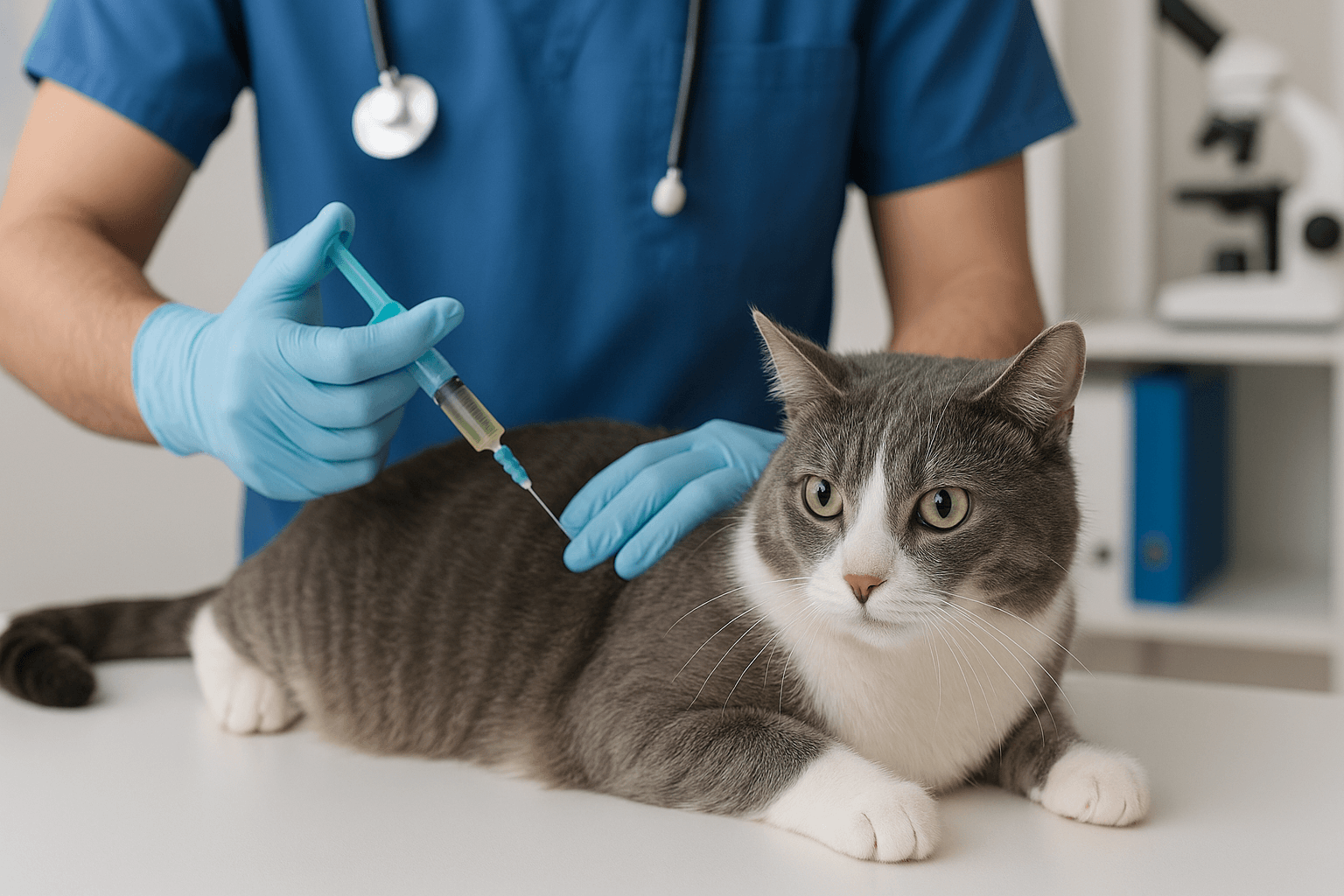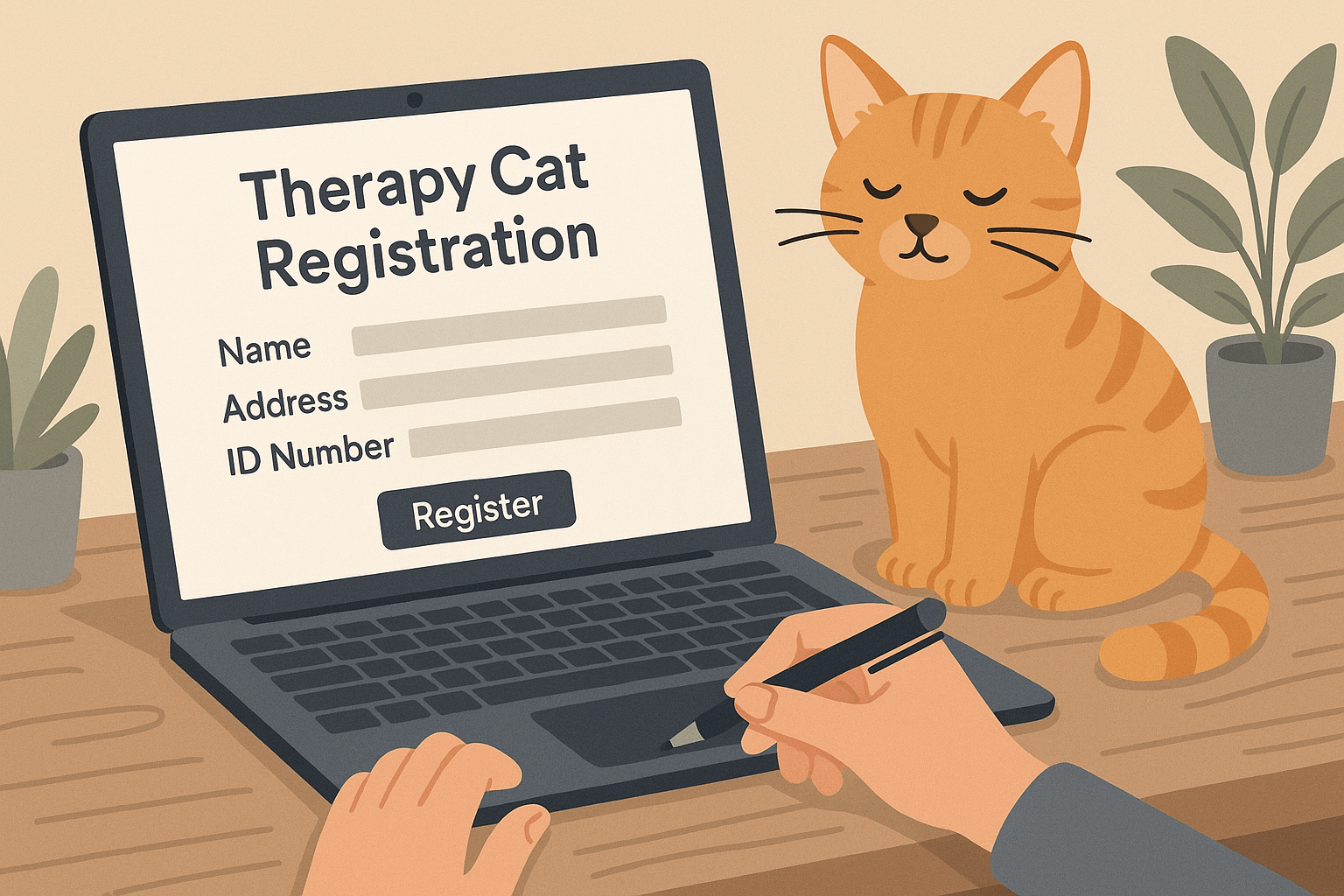Cat Teeth Tartar: Understanding and Preventing Dental Issues
When it comes to your cat’s health, dental care is just as important as proper nutrition and exercise. One of the most common dental problems in cats is the buildup of tartar on their teeth. This hard, yellowish substance forms when plaque hardens over time, leading to potential gum disease, tooth decay, and even systemic health issues if left untreated. But what causes tartar buildup, and how can you prevent it? In this blog post, we’ll explore everything you need to know about cat teeth tartar—its causes, effects, and practical solutions for keeping your feline friend’s smile healthy and bright.
Expert Insight: Understanding Plaque and Tartar Formation
“Plaque is the combination of food residue, saliva and bacteria that always coats the surface of the teeth following the chewing of food. Plaque is a soft, semi-liquid substance.
If plaque is not removed regularly, the plaque reacts with minerals in the saliva to form calculus, or tartar, the hard, brown substance that dentists need to remove from our teeth when we are having them cleaned professionally. Veterinary dentists need to remove this hard tartar from the teeth when it gathers.”
What Causes Cat Teeth Tartar?
Understanding the root causes of tartar buildup is the first step toward preventing it. Several factors contribute to the accumulation of tartar on your cat’s teeth, making regular dental care essential.
Plaque Formation:
Plaque is a sticky film made of bacteria that forms on teeth after eating. If not removed, it hardens into tartar within days.Poor Diet Choices:
Diets high in soft, wet food can lead to more food particles sticking to teeth, increasing the risk of plaque and tartar buildup.Lack of Chewing:
Cats that don’t chew enough, either due to eating only soft foods or having limited access to dental-friendly toys, are more prone to tartar.Genetic Factors:
Some cats may be genetically predisposed to dental issues, making them more susceptible to tartar formation.Infrequent Dental Care:
Without regular brushing or professional cleanings, tartar can accumulate unchecked, leading to serious dental problems.
By addressing these contributing factors, you can significantly reduce the risk of tartar buildup and promote better oral health for your cat.
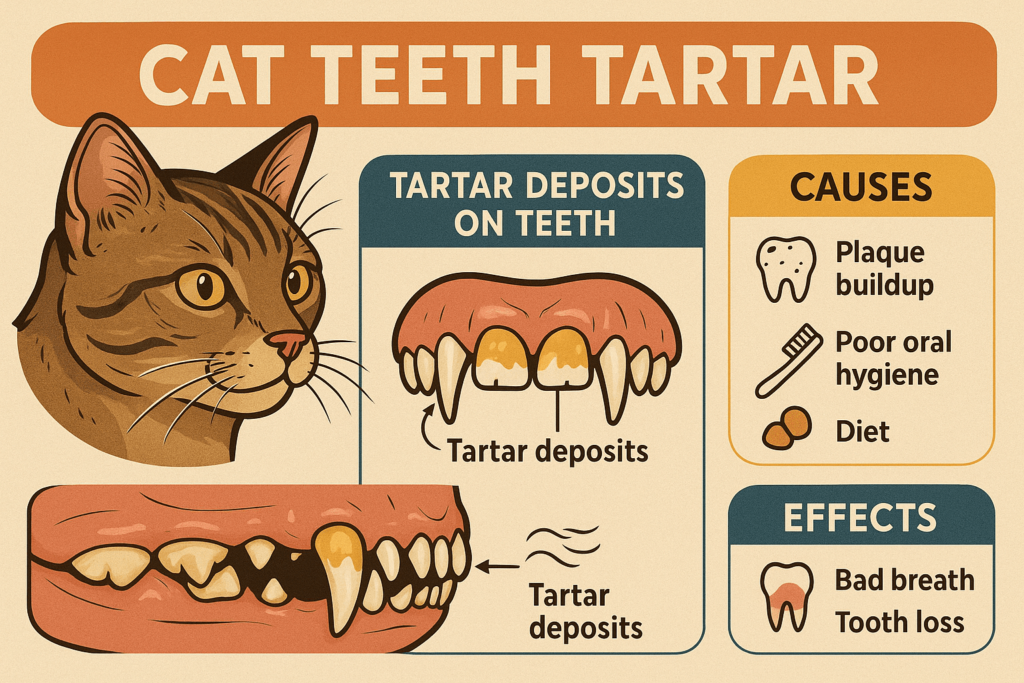
Signs Your Cat May Have Tartar Buildup
Detecting tartar early can prevent more severe dental issues down the line. Keep an eye out for these signs that your cat may be struggling with tartar buildup.
Bad Breath (Halitosis):
Persistent bad breath is often one of the first indicators of tartar and underlying dental problems.Yellow or Brown Deposits on Teeth:
Visible tartar appears as hard, discolored deposits near the gumline, particularly on the back teeth.Red or Swollen Gums:
Inflammation of the gums, known as gingivitis, is a common consequence of tartar buildup.Difficulty Eating:
Cats with dental pain may hesitate to eat, chew only on one side, or drop food while eating.Excessive Drooling:
Unusual drooling can indicate discomfort or irritation caused by tartar-related gum disease.
Recognizing these symptoms early allows you to take action before tartar leads to more serious health concerns.
Check this guide 👉How Should Cat Teeth Look? Best 7 Expert Tips!
Check this guide 👉Understanding Cat Teeth Anatomy: Best 7 Health Tips!
Check this guide 👉Understanding Cat Teeth Anatomy: Best 7 Health Tips!
Preventive Measures for Tartar | Risks of Untreated Tartar |
|---|---|
Regular tooth brushing | Gum disease and tooth loss |
Providing dental-friendly treats | Pain and difficulty eating |
Offering chew toys and bones | Systemic infections spreading to organs |
Feeding dry kibble instead of soft food | Bad breath and discomfort |
Scheduling annual vet checkups | Increased veterinary costs later |
How to Prevent Tartar Buildup in Cats
Prevention is key when it comes to managing cat teeth tartar. By incorporating these practices into your routine, you can help keep your cat’s teeth clean and healthy.
Brush Their Teeth Regularly:
Use a cat-specific toothbrush and enzymatic toothpaste to gently clean their teeth at least 2-3 times a week.Offer Dental Treats:
Dental treats are designed to scrape away plaque and tartar while satisfying your cat’s natural chewing instinct.Provide Chew Toys:
Rubber or textured toys encourage chewing, which helps remove plaque and strengthen teeth.Feed a Balanced Diet:
Incorporate dry kibble into their diet, as crunching on hard food can naturally reduce plaque buildup.Schedule Professional Cleanings:
Annual or biannual dental cleanings by a veterinarian ensure thorough removal of tartar and early detection of issues.
With consistent effort, these preventive measures can go a long way in maintaining your cat’s oral hygiene.
Common Misconceptions About Cat Dental Health
There are many myths surrounding cat dental care that can lead to confusion or neglect. Clearing up these misconceptions ensures you provide the best care for your pet.
“Cats Don’t Need Dental Care”:
Many believe cats naturally clean their teeth through chewing, but this isn’t always enough to prevent tartar.“Dry Food Alone Prevents Tartar”:
While dry food can help, it doesn’t replace the need for brushing or professional cleanings.“Tartar Isn’t Harmful Until It’s Severe”:
Even small amounts of tartar can lead to gum disease and other health complications over time.“Cats Hate Having Their Teeth Brushed”:
With patience and positive reinforcement, most cats can learn to tolerate—and even enjoy—brushing sessions.“Dental Problems Are Only About Teeth”:
Poor oral health can lead to systemic infections affecting the heart, kidneys, and other organs.
Understanding the truth behind these myths empowers you to prioritize your cat’s dental health effectively.
The Role of Genetics in Cat Dental Health
While environmental factors play a major role in tartar buildup, genetics can also influence your cat’s susceptibility to dental issues. Understanding these genetic predispositions helps tailor your approach to their unique needs.
Breed-Specific Risks:
Certain breeds, such as Persians and Siamese, are more prone to dental problems due to their facial structure.Immune System Variations:
Some cats have weaker immune responses, making them more vulnerable to gum infections caused by tartar.Tooth Alignment Issues:
Misaligned teeth can trap food particles, accelerating plaque and tartar formation.Saliva Composition:
Differences in saliva pH and enzymes can affect how quickly plaque hardens into tartar.Early Onset of Dental Problems:
Kittens from lines with poor dental health may develop tartar earlier than others.
Acknowledging these genetic factors allows you to take proactive steps tailored to your cat’s specific needs.
DIY Remedies for Cat Dental Care
If professional cleanings aren’t immediately accessible, there are simple DIY remedies you can try at home to support your cat’s dental health. These methods complement brushing and vet visits.
Coconut Oil Rubs:
Applying a small amount of coconut oil to your cat’s teeth can help reduce bacteria and plaque buildup.Herbal Mouth Rinses:
Pet-safe herbal rinses added to water bowls can freshen breath and promote gum health.Raw Meat Bones:
Supervised chewing on raw meat bones (not cooked) can naturally scrape away tartar.Dental Wipes:
Specialized wipes designed for pets can remove surface plaque without requiring full brushing.Probiotic Supplements:
Probiotics improve gut health and can indirectly support oral health by balancing bacteria levels.
These DIY solutions offer affordable and effective ways to enhance your cat’s dental care routine.
The Connection Between Oral Health and Overall Wellness
Your cat’s oral health is closely linked to their overall well-being. Neglecting dental care can lead to complications beyond their mouth, emphasizing the importance of regular attention to their teeth.
Heart Disease Risk:
Bacteria from gum infections can enter the bloodstream, potentially causing heart valve inflammation.Kidney Function Issues:
Chronic dental infections place stress on the kidneys, exacerbating existing conditions or triggering new ones.Liver Complications:
Oral bacteria can travel to the liver, leading to inflammation or infection in severe cases.Diabetes Management Challenges:
Cats with diabetes are more prone to gum disease, creating a cycle that worsens both conditions.Behavioral Changes:
Pain from dental issues can cause irritability, lethargy, or aggression, affecting your cat’s quality of life.
By prioritizing oral health, you’re not just protecting their teeth—you’re safeguarding their entire body.
Frequently Asked Questions About Cat Teeth Tartar
Can I use human toothpaste for my cat?
No, human toothpaste contains ingredients that are toxic to cats. Always use cat-safe enzymatic toothpaste.
How often should I brush my cat’s teeth?
Aim to brush your cat’s teeth 2-3 times a week for optimal results.
What if my cat resists brushing?
Start slowly by introducing the toothbrush and rewarding calm behavior. Gradually build up to full brushing sessions.
Are dental treats effective?
Yes, dental treats can help reduce plaque and tartar, but they should complement—not replace—regular brushing.
When should I see a vet for tartar removal?
Schedule a vet visit if you notice significant tartar buildup, bad breath, or signs of discomfort during eating.
Prioritizing Your Cat’s Dental Health
Maintaining your cat’s oral hygiene is a vital part of responsible pet ownership. Tartar buildup may seem like a minor issue, but its impact on your cat’s overall health can be significant. By understanding the causes, recognizing the signs, and implementing preventive measures, you can protect your feline companion from painful dental problems and costly treatments. Remember, a healthy mouth means a happier, healthier cat—and that’s something every pet owner can feel good about.
Is the Rubber Tree Cat Safe? Best 7 Expert Tips! Discover expert advice on keeping rubber plants safely in cat-friendly homes and learn top tips for pet-safe plant care.
Low Red Blood Cell Count in Cats: Best 7 Expert Tips! Discover causes, symptoms, and treatment options for feline anemia. Learn how to support your cat’s health effectively with expert advice.
Understanding Megacolon Treatment: Best 7 Expert Tips! Discover effective strategies to manage feline megacolon, from dietary changes to surgical options, ensuring your cat’s comfort and long-term health.
How to Register a Therapy Cat: Best 7 Expert Tips! Discover essential steps to certify your cat as a therapy animal, prepare them for training, and make a meaningful impact in therapeutic settings.

